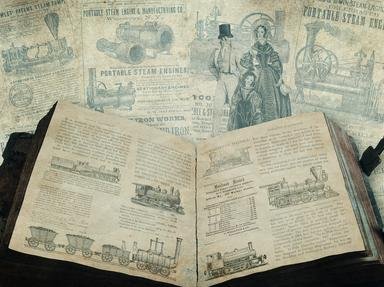Quiz Answer Key and Fun Facts
1. As you approach Guildeneye's mansion, you notice that it is marked by an optical motif taken from a famous book. Understanding its source may be important to understanding his devious psychology! You think back and recall that a faded billboard sign featuring a pair of disembodied, bespectacled eyes is a prominent symbolic element in what classic American novel?
2. You're lurking outside, wondering how best to get in, when a deliveryman approaches and rings the doorbell. The tune seems eerily familiar, and then you realize where you've heard it before. In 1982, "Rocky III" was released with this #1 hit song as part of its soundtrack. What was the title of Survivor's biggest hit?
3. In the front hallway you find a bust of Mary Ingalls. Could her life offer a clue to the ultimate plans of Guildeneye? You think back to what you know (or don't know!) about her:
The series of books by Laura Ingalls Wilder became a long-running television series called, of course, "Little House On The Prairie". The Ingalls family, as they built their home and life in the rugged upper Midwest post U.S. Civil War, encountered many a challenge as they prospered. As per the TV show (and historical entertainment is rather famous for taking many freedoms with facts) one travail was that the oldest daughter, Mary Ingalls, tragically lost her eyesight as a teenager. THAT is true in the midst of lots of other licenses taken with the history that really happened. Aside from that, which of the following observations is factual about the blind [but less remembered] Mary Ingalls?
4. As you descend to the depths of the mansion, you discover the arch-optometrist's computer. You have a thumb drive to download his data, but you need the password. Luckily, a note from Guildeneye is taped to the monitor, containing a personal password hint: "This structure is found in the eyes of many nocturnal animals, including cats and dogs, but only one ethnic group of humans possesses it." What's the password?
5. You carefully make your way to Guildeneye's library, where the secret passage to his inner sanctum is supposedly located. Prominently displayed is a dictionary turned to the "extol - eyeteeth" page, and you can't resist glancing at it; you know that many etymologists would give their own eyeteeth to know how all the fuss over eyeteeth erupted. Which of the following do you find has been claimed regarding the etymology of "eyeteeth"?
6. At the end of the library is a single shelf with four lonely books of Roman poetry. Remove the right book, and the wall will slide away to reveal the passage to Guildeneye's lair; the wrong book will lead to certain death. Naturally, after your prior experiences in this mansion, you guess that the favored poetry volume might hinge on eyes somehow. You dimly recall a first couplet that may point you to the correct book:
"Cynthia caught me with her eyes, poor me,
Never before touched by any love."
So begins the work of which somewhat obscure Roman lyric poet?
7. You slide through the opening in the wall and into the secret passage. Unsurprisingly, it's booby-trapped: a bomb will go off unless you can insert an eye-related book into the correct spot in Guildeneye's science fiction collection. In the Expanded Universe (EU) of "Star Wars", where does the novel "Splinter of the Mind's Eye" fit into the storyline?
8. As you pass through the corridor, another song - triggered by a motion detector? - begins to play. You find yourself singing along under your breath; you've always loved this one. This huge Kim Carnes hit from 1981 invited us to consider a woman who knows what she wants and isn't afraid to go after it. She's described as having hair of "Harlow gold", and "Greta Garbo stand off sighs", which made "all the boys think she's a spy". What star's name was used to describe her eyes?
9. The secret passage opens out onto four doors, each marked with a word or a phrase. From other infiltrators, you know that three doors lead to inner sancta, while the fourth leads into an Indiana Jones-style pit of snakes. The door with the phrase not related to the eye is the door to avoid. You recall that, for obvious reasons, the eye as a symbol may be spied throughout history in world mythology, folklore and religious imagery. Which of the following does NOT use the eye in any particular way?
10. The second door that you try leads to a room with a world map on one wall and books strewn across a conference table. At last - the room where Guildeneye's evil plans are laid! Your sources have told you that his very wickedest plan is described in a memo concealed within a book of philosophy, penned by a famous gentleman code-named "Soul-Seat." You see four philosophical tracts on the table, and you remember that esoteric spiritual tradition has long proclaimed that the "Pineal Gland," which is located in the center of the human brain and directly behind the eyes, is in fact a "third eye" that enables one to see beyond the physical world and into the hidden realms beyond. Which philosopher coined the term "Seat Of The Soul" for this pea-sized mystery spot in the human brain?
Source: Author
CellarDoor
This quiz was reviewed by FunTrivia editor
ozzz2002 before going online.
Any errors found in FunTrivia content are routinely corrected through our feedback system.
